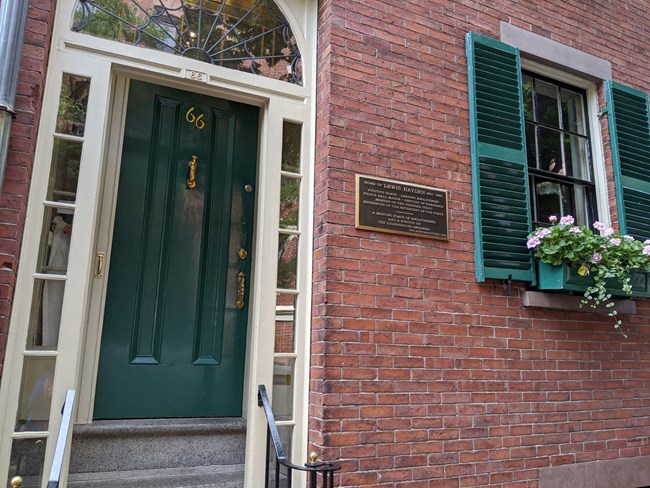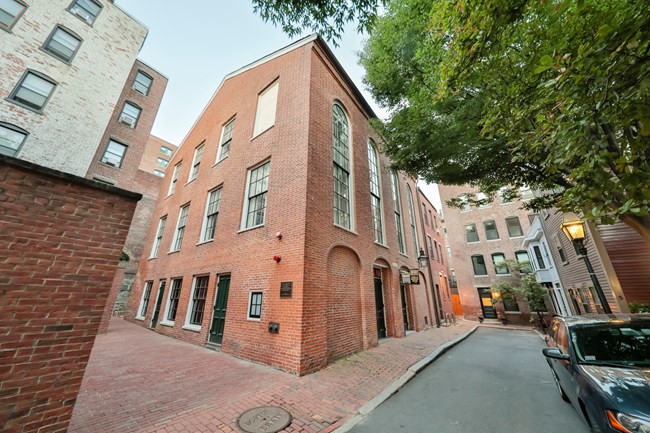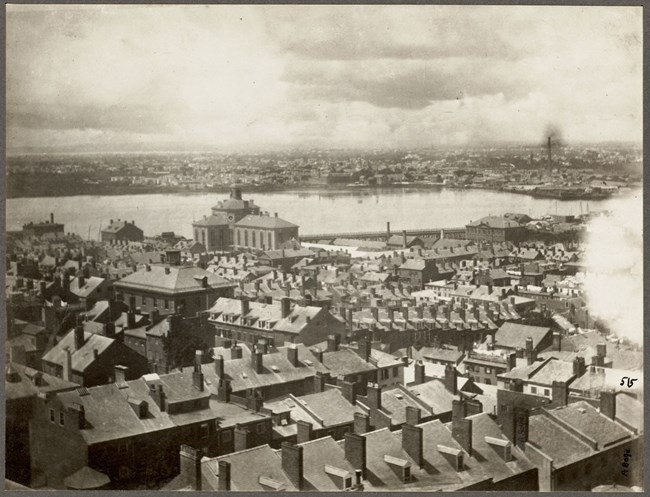|
Matt Teuten IntroductionBoston is a historic city, and its people have an even longer story. What will climate change mean for its future? Humans have lived on the Shawmut Peninsula, now called Boston, for thousands of years. Members of the Massachusett Tribe lived here throughout the seasons, until the arrival of European settlers. Violent displacement and colonization fragmented the lives and cultures of the original residents of this area. The Massachusett Tribe has remained resilient despite these atrocities and continue to steward the lands and waters of this area today. Not long after Europeans arrived to this area, a new system based on trade and human exploitation began. Traders captured, enslaved, and forcibly brought Africans to the new colonies. Slavery drove the growth and economic development of what became the United States. However, through the activism, petitions, and lawsuits brought by free and enslaved people of African descent and their allies, calls grew stronger for the abolition of slavery. In 1783, the Supreme Judicial Court of Massachusetts effectively abolished slavery in the state. ca. 1851-1899, Boston Public Library Beginning in the 1760s, a few free Black Bostonians purchased land on the north slope of Beacon Hill as a prospective place of settlement. While wealthier White Bostonians built homes on the south slope of Beacon Hill, the north slope remained undeveloped due to existing ropewalks, privately owned pasture land, and limited access to clean water. Black Bostonians, such as Scipio Fayerweather and Tobias Locker, built housing for themselves and others on their land on the north slope. By the 1790s, more members of the Black community had joined them in developing the area. As a result, the north slope of Beacon Hill quickly grew into an active free Black community. Throughout the 1800s, this community, with the aid of its allies, continued to advocate for civil rights while also calling for the abolition of slavery in the United States. They won equal education rights for Black students and developed a network of safehouses to support the city’s growing Underground Railroad. Today, the Black Heritage Trail brings the stories of incredible African American changemakers from this era to visitors and residents alike. Boston has a reputation for long, cold winters, spectacular falls, and short but pleasant springs and summers. Now, climate change has shifted Boston’s climate to one more like the Mid-Atlantic: mild, dry winters and hot summers with extreme variations in rainfall. Not only will Boston landmarks such as the Robert Gould Shaw 54th Massachusetts Regiment Memorial and the African Meeting House become more challenging to visit during more frequent heat waves, but historic buildings such as the George Middleton House and the Charles Street Meeting House will have to adapt for extreme weather events that did not exist in the past. ThreatsUrban Heat Island EffectUrban areas, such as town centers and cities, are covered in asphalt, pavement, and cement – dark surfaces that absorb the sun’s warmth. These areas heat up faster and stay hot longer than greener and less developed areas. Researchers call this the "urban heat island effect." As the climate warms and cities grow, this effect is intensifying. In summer months, this effect can become dangerous to human health, particularly in underserved communities that have far less natural space than wealthier communities. A 2021 heat resilience study conducted by the City of Boston showed that historically underserved areas of the city can be over 15 degrees hotter than well-resourced communities during a heat wave. Understanding Boston as an Urban Heat Island 

Left image
Right image

Preparing for Heat
Learn about the City of Boston's Heat Plan on how the city is addressing hotter summers. 
Keeping Cool in the Heat
Check out the City of Boston's resources for staying cool in extreme heat. 
NPS PreservationThe historic homes and buildings along the Black Heritage Trail have evolved over time. Some remain privately-owned single family homes, while others have been converted into condominiums or museums. All of them still feature historic architecture and features that make the Beacon Hill neighborhood unique. As temperatures rise and storms become more intense, these historic structures will need to adapt to conditions they were not built to handle. Extreme temperatures can affect aged glass and wooden beams, while heavy rainfall events threaten basements and the many small alleyways of Beacon Hill. As we prepare for extreme weather, we can also consider ways to make these sites more energy efficient and resilient! Imagination and CourageClimate change will not just change weather patterns: it will change the way we live and play in our city. Seasonal traits that we used to rely on, like crisp fall days or cool summer nights, will be less reliable. Historic homes will need to be protected from extreme weather events, and outdoor sites will require reimagining. Residents of Boston fighting for abolition and civil rights lived in an unjust time, when personal beliefs and laws of government protected bigotry and injustice. Yet these same people, such as Lewis and Harriet Hayden, persevered in their work with the unshakable belief that the world could change. Year after year, decade after decade, Bostonian activists carried on the civil rights movement, and continue fighting for justice to this day. » How might we take inspiration from the tactics of abolitionists and civil rights activists of the past in our struggle against climate change today? Climate change is the greatest challenge many of us have faced in our lifetimes. By looking into Boston’s past, we can find a way forward to a future that is healthy and sustainable for all. 
Matt Teuten Create Spaces of RefugeThe Underground Railroad protected individuals and families fleeing slavery. These freedom seekers rarely had any personal belongings, let alone documents or paperwork to "prove" their freedom. By building a network of safe houses and knowledge in Beacon Hill and greater Boston, local abolitionists helped people rebuild their lives in a new place. » How can Boston prepare for and help people fleeing climate disasters, such as sea level rise, flooding, or heat waves? Abolitionists and civil rights activists created safe spaces where they could share ideas and uplift the stories of enslaved people and underrepresented Americans. From businesses to houses of worship and private homes, members of the community created places of refuge to provide a sense of relief and respite. » What kinds of safe spaces do we need in a changing climate? Learning from Traditional KnowledgeAfricans kidnapped and trafficked from West and Central Africa and Indigenous peoples enslaved by colonists safeguarded pieces of their culture from erasure. From names and words to food and music, these cultural touchstones have become an indelible part of the United States. In recent decades, people from hot and tropical areas of the world have come to call Boston home – bringing with them cultural knowledge of how to thrive in hotter and wetter climates. » What kinds of skills and practices can Bostonians learn from new residents? ResourcesLearn what NPS, the City of Boston, and park partners are doing to become more climate resilient. 
2024 BOAF Climate Futures Summary
Read the NPS Climate Change Response Program's report on observed climate changes and plausible climate futures for our park. 
Climate Ready Boston
Climate Ready Boston is the City's initiative to prepare for the impacts of climate change. 
Stone Living Lab
The Stone Living Lab conducts transformative research and outreach to make vulnerable coastal regions adaptive to climate change. 
National Park Service & Climate Change
The National Park Service is addressing challenges brought on by climate change through a comprehensive strategy. |
Last updated: September 24, 2025


